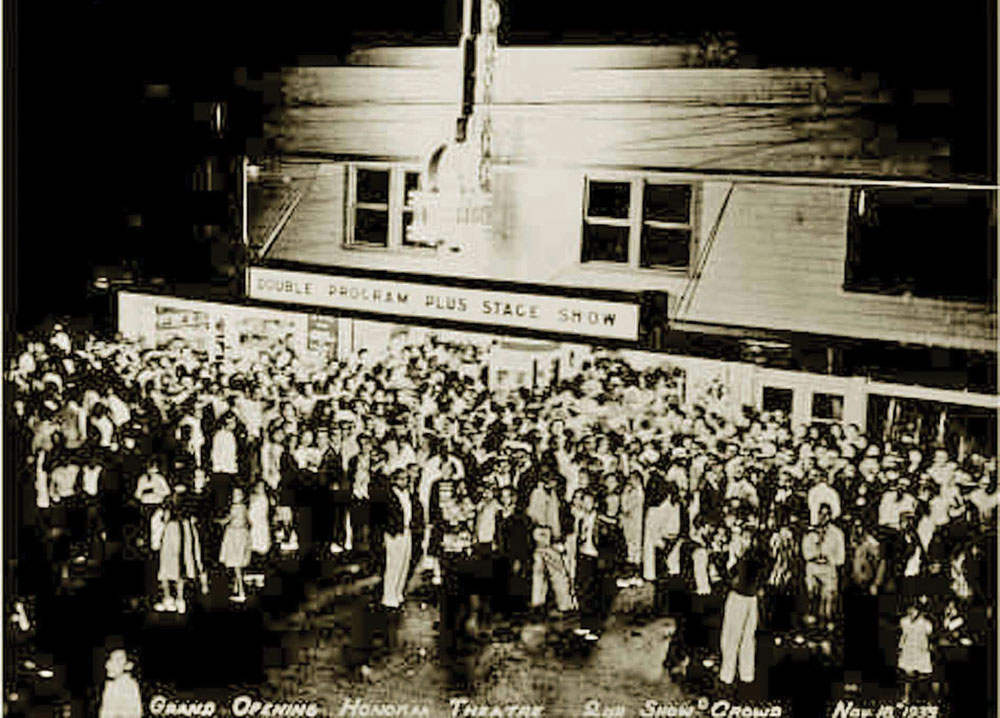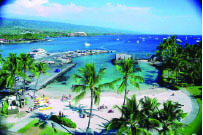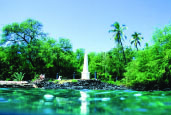
Then & Now: Murder & Movies in Old Honoka‘a Town

By Ann C. Peterson
For many decades, sugar was king throughout the island chain, and in no place was this more so than in the folksy village of Honoka‘a in the northeast district of Hamakua. At its core, Honoka‘a embodied the hustle and bustle of diversity—in business and in culture—and served as the district’s commercial center.
The earliest sugar operation in the area began in 1876 when Honoka‘a Sugar Plantation started, planting 500 acres of cane with Hawaiian labor and installing a rudimentary mill—the first one in the Hamakua area. Just two years later, the Honoka‘a Sugar Company was established, swallowing the former operation while adding more machinery, refining and improving shipping methods and expanding labor.
With Hamakua’s rugged shoreline and steep cliffs, shipping was indeed a problem and required ingenious solutions. In the earlier days, horse or donkey-drawn wagons were used to haul cane. Later, six miles of rail lines and two flumes carrying water from Waipio Valley were built and taken over by the Honoka‘a Sugar Company in 1915.

Getting the shipment out to the boats and supplies back in was also an evolution of ideas, beginning with the building of a concrete wharf and a precarious crane to lift goods and equipment to shore and lower the raw cane to waiting boats. Ultimately, incline rail lines allowed closer access—and a thrilling steep ride. By 1919, these innovations allowed the sugar company to ship directly to the mainland instead of through Honolulu.
The wave of Asian immigration to Hawai‘i started with single men from China in 1852. For the most part, they worked their three-year contract, saved their money and returned home. The Portuguese, who began arriving in the 1870s, were a much different story—arriving in family units and soon sending for their extended family members. Japanese men began arriving in 1885 and once settled in, sent back to Japan for “picture brides.” Filipinos were the last immigrant group to arrive in the 1920s, with a few Puerto Ricans, Koreans, Russians and Spaniards added into the multicultural mix.
Work on the sugar plantation was harsh. A typical immigrant laborer was indentured for three years and worked 10 hours a day, six days a week, or 27 days a month, and made 90 cents a day, or $20/month.
Katsu Goro, who arrived in 1885 on the first Japanese ship in the islands, endured the years of labor, saved some money and bought a store in town. He had worked as a clerk in the busy, multicultural port of Yokohama and knew some English. With this skill, and his status among his peers, he bridged the cultural divide. Laborers would come to him with their problems and he tried to give advice, which was not appreciated by their employers. It resulted in death threats, which were very real in 1889. He is one of the earliest heroes of the labor movement, and a memorial to his efforts still stands along Mamane Street in Honoka‘a today. There were other efforts to increase laborers’ pay and quality of life, but it wasn’t until Hawai‘i became a state and companies could no longer indenture their workers that conditions slowly improved.
While conditions were especially bad for the workers, there was one calamity that transcended race and economic standing—the plague! The first case was reported in 1910 and the last in 1949. Plague-ridden rats thrived in Hamakua with its abundant fruit trees and dense vegetation. While the Territorial Board of Health held some responsibility, the rural area was pretty much on its own and it wasn’t until the discovery of sulfa medicines and antibiotics in the 1940s that the plague disappeared from Hamakua. Sadly, 112 victims contracted the disease, and 109 died.
Meanwhile, the number and size of sugar mills was growing and new industries were being introduced. As a part of a reforestation effort in 1916, Honoka‘a Sugar Company became the world’s oldest commercial producer of macadamia nuts, and in the same year, its Honoka‘a Ranch division was started. The ranch covered 2,600 acres of grazing land with 600 head of cattle and set a new tone and style for the burgeoning community of Honoka‘a.
If you were going shopping or going out looking for fun in the 1930s on Hawai‘i Island, chances are you were headed for Honoka‘a. It was the happening place with pool halls, saloons, and three large theaters, including the Honoka‘a People’s Theatre, boasting more than 500 seats. The theater showed films from all over the world and drew in folks from the sugar mill camps of Haina, Kukuihaele, Paauhau, Kapulena, and New Stable.
Today, a visit to Honoka‘a will make these by-gone days come alive. In the ranch-style architecture and lush surroundings, visitors can find everything from an eclectic mix of antiques to delicious fudge. Plus, there are so many unique events and activities. Honoka‘a hosts a Western Week, complete with a down-home rodeo with top athletes. And the Honoka‘a People’s Theatre is still serving as an economic draw with the Hamakua Music Festival each fall.
From sugar to ranching to lively theatre, what’s not to love about Honoka‘a on the Hamakua Coast? ❖


